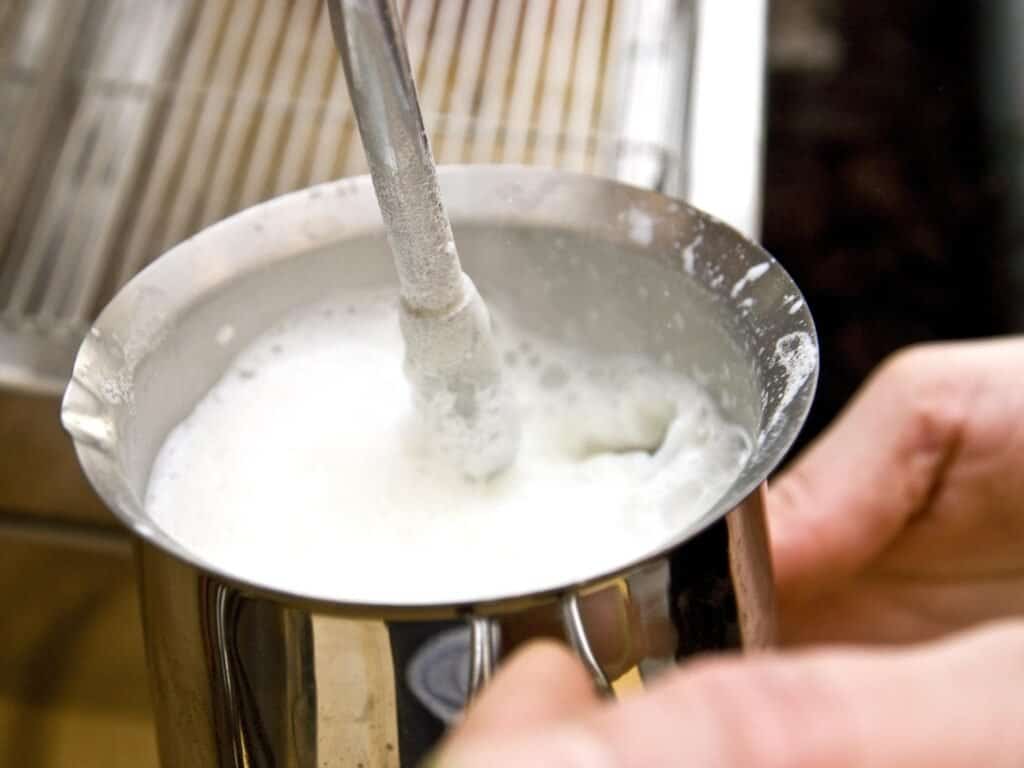How to Make Perfect Cappuccino Foam: A Step-by-Step Guide

Cappuccino is a popular Italian coffee beverage that is enjoyed by millions of people around the world. One of the key components of a great cappuccino is the foam. The foam is what gives the cappuccino its signature texture and taste, and it is an essential part of the coffee-making process. In this article, we will show you how to make cappuccino foam like a pro.
To create perfect cappuccino foam, you need to understand the components that go into making it. We will cover the different types of milk that can be used, the importance of temperature, and the role of air in creating the perfect foam. We will also discuss the equipment you will need, such as a milk frother and steam pitcher, as well as some common mistakes to avoid.
Creating the perfect cappuccino foam is an art form, and it is one that takes practice to master. With the right ingredients, equipment, and techniques, anyone can create a delicious and creamy foam that will take their cappuccino to the next level. So, let’s get started and learn how to make cappuccino foam like a professional barista.
Key Takeaways
- Understanding the components of cappuccino foam is essential for creating the perfect texture and taste.
- Choosing the right ingredients, such as whole milk and freshly roasted coffee, is crucial for making great cappuccino foam.
- Essential equipment, such as a milk frother and steam pitcher, can help you create the perfect foam.
History of Cappuccino
Cappuccino is a coffee beverage that originated in Italy in the early 1900s. It is a popular drink that is enjoyed around the world today. The history of cappuccino is closely tied to the history of coffee and cafes in Europe.
The first record of cappuccino we have found was in the 1930s. The drink was named after the Capuchin friars, who wore brown hoods that resembled the color of the coffee when it was mixed with milk. The drink was made by mixing espresso with milk and topping it with foam.
The popularity of cappuccino gradually grew in cafes and restaurants across Italy. It became a popular drink in the 1950s and 1960s, and was later introduced to other countries in Europe and around the world. Today, cappuccino is a staple in coffee shops and cafes worldwide.
The traditional cappuccino is made with equal parts espresso, steamed milk, and foam. The foam is created by aerating the milk with steam, which creates a creamy texture. The drink is typically served in a small cup, and is often enjoyed in the morning or after a meal.
In conclusion, the history of cappuccino is closely tied to the history of coffee and cafes in Europe. It is a popular drink that has been enjoyed for over a century, and continues to be a staple in coffee shops and cafes around the world.
Understanding the Components
When it comes to making cappuccino foam, there are two main components that we need to understand: the espresso base and the milk foam. Let’s take a closer look at each of these components.
Espresso Base
The espresso base is the foundation of any cappuccino. It is made by forcing hot water through finely ground coffee beans using an espresso machine. The result is a concentrated shot of coffee that is rich, dark, and full of flavor.
To make a cappuccino, we typically use one or two shots of espresso as the base. This is then combined with steamed milk and foam to create the final drink. The amount of espresso used can vary depending on personal preference and the size of the cup being used.
Milk Foam
The milk foam is what gives a cappuccino its signature frothy texture. It is created by heating milk and then using a steam wand to introduce air into the milk, creating a layer of foam on top.
When making cappuccino foam, it is important to use the right type of milk. Whole milk is the most commonly used, as it has the right balance of proteins and fats to create a thick, creamy foam. However, other types of milk can also be used, including skim, soy, or almond milk.
To create the perfect foam, it is important to heat the milk to the right temperature and use the steam wand correctly. Overheating the milk or not introducing enough air can result in a thin, watery foam that will not hold up in the drink.
Overall, understanding the components of a cappuccino is key to creating the perfect foam. By using the right amount of espresso and the right type of milk, and by steaming the milk correctly, we can create a delicious, frothy cappuccino that is sure to impress.

Choosing the Right Ingredients
When it comes to making cappuccino foam, choosing the right ingredients is crucial. The quality of the milk and additional elements can make or break the texture, taste, and overall experience of your cappuccino. In this section, we will explore the different types of milk and additional elements you can use to make the perfect cappuccino foam.
Types of Milk
The type of milk you use plays a significant role in the texture and taste of your cappuccino foam. Here are some of the most common types of milk used for making cappuccino foam:
| Type of Milk | Description |
|---|---|
| Whole Milk | Rich and creamy, with a higher fat content that produces a velvety texture and a sweet taste. Ideal for those who want a classic cappuccino flavor. |
| 2% Milk | Lower in fat than whole milk, but still produces a creamy texture and a slightly tangy taste. Ideal for those who want a lighter cappuccino. |
| Skim Milk | Very low in fat, produces a light and airy texture, but lacks the creaminess and sweetness of whole milk. Ideal for those who want a low-fat cappuccino. |
| Oat Milk | A non-dairy option that produces a creamy and slightly sweet taste. Ideal for those who are lactose intolerant or vegan. |
Additional Elements
In addition to milk, there are several additional elements that you can use to enhance the flavor and texture of your cappuccino foam. Here are some of the most common additional elements used for making cappuccino foam:
- Sugar: Adds sweetness to the cappuccino and helps to balance the bitterness of the espresso.
- Cocoa Powder: Adds a rich chocolate flavor to the foam and can be used to create latte art.
- Cinnamon and Spices: Adds a warm and spicy flavor to the foam and can be used to create unique flavor combinations.
- Syrups: Adds a variety of flavors such as vanilla, caramel, and hazelnut to the foam and can be used to create flavored cappuccinos.
By choosing the right milk and additional elements, you can create a cappuccino foam that is perfect for your taste preferences. Experiment with different types of milk and additional elements to find the perfect combination that suits your taste.
Essential Equipment
To make the perfect cappuccino foam, we need to have the right equipment. Here are the essential tools we need:
Espresso Machine
The first and most important piece of equipment is an espresso machine. The espresso machine must be capable of producing high-pressure steam to create the perfect foam. We recommend using a semi-automatic or automatic espresso machine, which has a built-in steam wand.
Milk Frother
A milk frother is another essential tool for making cappuccino foam. The frother can be a handheld electric device, a manual whisk, or even an immersion blender. We recommend using a handheld frother or a handheld milk frother for ease of use.
Thermometer
A thermometer is necessary for accurately measuring the temperature of the milk. The ideal temperature for steaming milk is between 140°F and 150°F. We recommend using a digital thermometer, which is more accurate and easier to read than a traditional thermometer.
To create the perfect foam, we also need a metal pitcher or frothing pitcher. The pitcher should be made of stainless steel and have a capacity of at least 12 ounces. The pitcher’s size is essential because it affects the milk’s ability to create a stable foam.
In summary, we need an espresso machine, a milk frother, a thermometer, and a metal pitcher or frothing pitcher to create the perfect cappuccino foam. With the right equipment and techniques, we can create a creamy, velvety foam that complements our espresso perfectly.
Creating the Perfect Foam
Creating the perfect foam is essential for making a delicious cappuccino. The foam layer not only adds an aesthetic appeal to the drink but also enhances the taste and texture. In this section, we will guide you through the process of creating the perfect foam for your cappuccino.
Heating the Milk
The first step in creating the perfect foam is heating the milk. Cold milk does not foam well, so it’s essential to heat it to the right temperature. We recommend heating the milk to around 140-150°F (60-65°C). You can use a thermometer to check the temperature or simply heat the milk until it’s hot to the touch.
Frothing the Milk
Once the milk is heated, it’s time to froth it. Frothing milk involves introducing air into the milk to create microbubbles, which will give the foam its texture. There are several ways to froth milk, including using a steam wand on an espresso machine, a handheld frother, or a French press.
When using a steam wand, start by purging it to remove any water. Then, place the steam wand just below the surface of the milk and turn it on. As the milk starts to froth, lower the pitcher to submerge the wand fully and continue frothing until you achieve the desired texture.
If you’re using a handheld frother, simply place it in the milk and turn it on. Move the frother up and down to create microbubbles and achieve the right texture.
Achieving the Right Texture
The texture of the foam is crucial in creating the perfect cappuccino. The ideal texture is known as microfoam, which is a velvety, creamy foam with tiny, uniform bubbles. To achieve this texture, it’s essential to froth the milk correctly and create the right amount of microbubbles.
When frothing the milk, it’s important to keep the pitcher at an angle and swirl it gently to distribute the microbubbles evenly. This will help create a smooth, velvety texture. Once you’ve achieved the right texture, pour the milk into your cup, holding back the foam with a spoon until you’ve filled the cup with milk. Then, spoon the foam on top of the milk, creating a layer of microfoam.
In conclusion, creating the perfect foam for your cappuccino requires heating the milk to the right temperature, frothing it correctly, and achieving the right texture. By following these steps and experimenting with different techniques, you can create a delicious cappuccino with a perfect foam layer every time.
Pouring Techniques
When it comes to making cappuccino foam, the pouring technique is just as important as the foam itself. There are two basic pouring techniques that you can use to create a cappuccino: the basic pour and latte art.
Basic Pour
The basic pour involves simply pouring the milk into the espresso. To do this, hold the pitcher with the milk in your right hand and the cup with the espresso in your left hand. Tilt the cup slightly and pour the milk into the center of the espresso. As the milk hits the espresso, it will create a layer of foam on top.
Latte Art
Latte art is a more advanced pouring technique that involves creating designs in the foam. To create latte art, you will need to start with a good quality espresso and well-textured milk.
To begin, pour the milk into the espresso as you would with the basic pour. Then, use a spoon to hold back the foam as you pour the milk into the cup. Once the cup is about three-quarters full, gently shake the pitcher to create a layer of foam on top of the milk.
To create a design, use a toothpick or a latte art tool to drag through the foam. You can create a variety of designs, including hearts, flowers, and even animals. With practice, you can become quite skilled at creating latte art designs.
In conclusion, the pouring technique is an important part of creating a perfect cappuccino. Whether you are using the basic pour or creating latte art, it is important to use well-textured milk and a good quality espresso to get the best results. With practice, you can become a master at creating beautiful cappuccinos that are both delicious and visually appealing.
Serving Suggestions
When it comes to serving cappuccino, there are a few things to keep in mind to ensure that you’re presenting the perfect cup. Here are some serving suggestions to help you get started:
Choosing the Right Cup
The first step to serving a great cappuccino is choosing the right cup. A traditional cappuccino cup is small, holding only 6 ounces of liquid. This size is perfect for the classic cappuccino, which is made up of equal parts espresso, steamed milk, and foam. If you’re serving a larger cappuccino, you may want to use a coffee cup instead.
Iced Cappuccino
If you’re looking for a refreshing way to enjoy cappuccino, try making an iced cappuccino. To make an iced cappuccino, simply pour your cappuccino over ice and add a splash of milk. You can also add a flavored syrup for an extra burst of flavor.
Cafe Au Lait
If you prefer a milder coffee flavor, try serving a cafe au lait. This drink is made by combining equal parts brewed coffee and steamed milk. It’s a great option for those who don’t like the intensity of espresso.
Dry Cappuccino
For those who prefer a stronger coffee flavor, a dry cappuccino is a great option. This drink is made by adding less steamed milk and more foam to the espresso. The result is a stronger coffee flavor with a light, airy foam on top.
Overall, serving a great cappuccino is all about paying attention to the details. By choosing the right cup, experimenting with different variations, and focusing on the details, you can create a truly memorable coffee experience.
Common Mistakes and How to Avoid Them
When it comes to making cappuccino foam, there are a few common mistakes that can ruin your drink. Here are some of the most common mistakes and how to avoid them:
Using the Wrong Milk
One of the biggest mistakes people make when making cappuccino foam is using the wrong milk. Whole milk is the best option for making cappuccino foam because it has the right amount of fat and protein to create a creamy texture. Skim milk and other low-fat milks don’t have enough fat to create a creamy texture, and non-dairy milks like almond or soy milk can be too thin.
Not Using Fresh Milk
Another mistake people make is not using fresh milk. Milk that has been sitting in the fridge for too long can lose its ability to create foam. Make sure to use fresh milk that hasn’t been sitting in the fridge for more than a few days.
Not Heating the Milk Properly
Heating the milk to the right temperature is also important for creating good cappuccino foam. The ideal temperature for heating milk is between 140°F and 160°F. If the milk is too hot, it can scorch and create a burnt taste. If the milk is too cold, it won’t create enough foam.
Using the Wrong Method
There are a few different methods for creating cappuccino foam, and using the wrong method can lead to a subpar drink. The most common methods are using a steam wand, using a hand-held frother, or using a French press. Each method requires a different technique, so make sure to follow the instructions carefully.
Rushing the Process
Finally, rushing the process can lead to a poor-quality cappuccino foam. Take your time and be patient when creating cappuccino foam. Rushing can lead to uneven foam, too much foam, or not enough foam.
By avoiding these common mistakes, you can create delicious cappuccino foam that will impress even the most discerning baristas.
Conclusion
Making cappuccino foam can be a fun and rewarding experience, especially if you’re a coffee lover who wants to enjoy a homemade cappuccino. With the right tools and techniques, you can create a delicious coffee beverage that is both rich in flavor and visually appealing.
In this article, we’ve explored several methods for making cappuccino foam, including using a steam pitcher, frother, or French press. We’ve also discussed the importance of using whole milk to achieve a soft and dense foam, as well as the difference between cappuccino foam and latte foam.
When making cappuccino foam, it’s important to remember that there is no one-size-fits-all approach. The method you choose will depend on your personal preferences, the equipment you have available, and the level of expertise you have in making coffee beverages.
Whether you’re a beginner or an experienced barista, making cappuccino foam is a skill that can be developed over time. With practice and patience, you’ll be able to create a delicious and visually stunning coffee beverage that will impress your friends and family.
So, go ahead and experiment with different methods and techniques for making cappuccino foam. Who knows, you might just discover your new favorite way to enjoy this classic coffee beverage!






One Comment